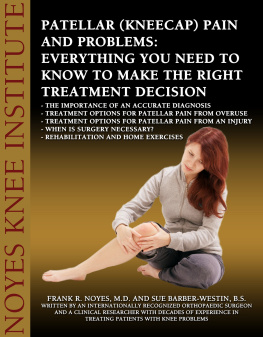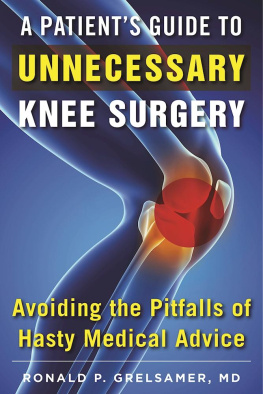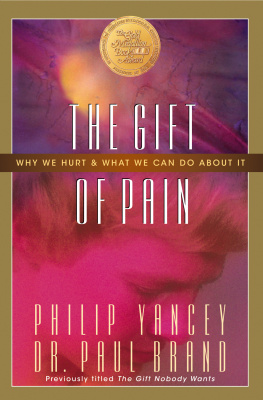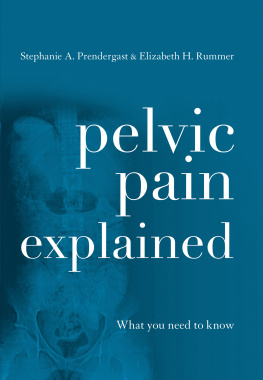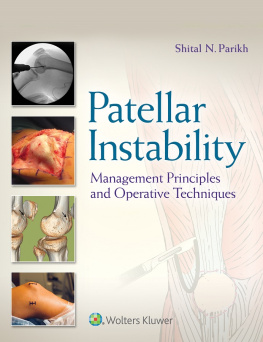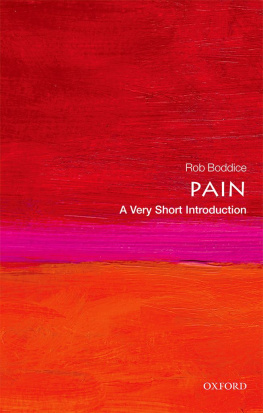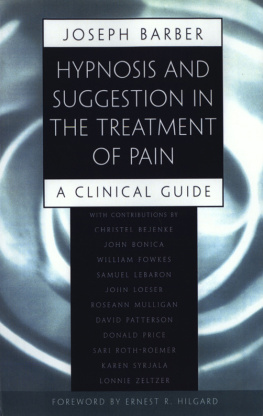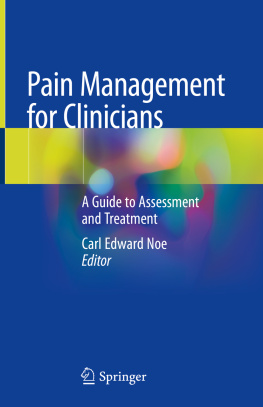Patellar (Kneecap) Pain and Problems: Everything You Need to Know to Make the Right Treatment Decision
The importance of an accurate diagnosis Treatment options for patellar pain from overuse Treatment options for patellar pain from an injury When is surgery necessary? Rehabilitation and home exercises
Frank Noyes, M.D.
Sue Barber-Westin
Copyright 2012 by Frank Noyes, M.D.
Authors: Frank R. Noyes, M.D. and Sue D. Barber-Westin, B.S.
Publish Green
212 3rd Ave North, Suite 290
Minneapolis, MN 55401
612.455.2293
This eBook is for educational purposes only. Every effort has been made to ensure that the information contained herein is as accurate as possible at the time of writing. The contents of this eBook have been compiled through the authors research and clinical experience, as well as research findings from other major orthopaedic research centers.
This eBook should not be used for self-diagnosis and treatment of kneecap pain. Only a qualified orthopedist or sports medicine-trained physician can make a definitive diagnosis of this problem. Only use this eBook for informational purposes. Health-care professionals have different opinions about how knee problems should be treated. Changes in the treatment of knee problems do occur, so some of the information in this eBook may over time become outdated.
The authors cannot be held responsible for any error, omission, contrary interpretation of the subject matter, or dated material. They assume no responsibility for any outcome of applying the information in this eBook by a patient or other health care professional.
All rights reserved. No part of this eBook may be reproduced or transmitted in any form or by any means, electronic or mechanical, including photographs and illustrations, recording, or by any information storage or retrieval system, without permission in writing, and in advance, from Frank Noyes, M.D. This eBook is produced by the Noyes Sports Medicine Institute, a non-profit foundation dedicated to improving the physical activity and health of patients through research, education, and treatment of sports injuries and knee disorders.
Some of the photographs and illustrations in this eBook are reprinted with permission from Noyes' Knee Disorders. Surgery, Rehabilitation, Clinical Outcomes, Saunders, Philadelphia, PA.
Thanks to Joe Chovan for producing several of the illustrations.
ISBN: 978-1-935204-85-5
About the Authors
Dr. Frank Noyes is an internationally recognized orthopaedic surgeon and researcher who has specialized in the treatment of knee injuries and disorders for nearly 4 decades. He is the founder and chairman of the Cincinnati SportsMedicine and Orthopaedic Center and its nonprofit research foundation. Dr. Noyes completed his orthopaedic training at the University of Michigan Medical Center. He then received a 4-year clinical and research appointment as an orthopaedic surgeon in the United States Air Force, was commissioned as a Lieutenant Colonel, and began his landmark research into knee ligament injuries, the effects of immobilization, biomechanics of ligaments, prevention of ACL injuries in the female athlete, the diagnosis of many knee injuries and problems, and the results of treatment for a variety of knee disorders. Along with Dr. Edward Grood, Dr. Noyes established one of the first biomechanics laboratories in the United States at the University of Cincinnati College of Engineering. The laboratory was subsequently named in his honor as the Noyes Tissue Engineering and Biomechanics Laboratory.
Dr. Noyes has won every conceivable award for his clinical and laboratory research from societies such as the American Academy of Orthopaedic Surgeons, the American Orthopaedic Society of Sports Medicine, the Orthopaedic Research and Education Foundation, as well as the University of Cincinnati. He was inducted into the American Orthopaedic Society for Sports Medicines Hall of Fame in 2008. Dr. Noyes has been selected by his peers as one of the Best Doctors in America every year since 1992.
Dr. Noyes has published over 260 research studies and textbook chapters on many different types of knee injuries and disorders. He edited a textbook entitled, Noyes Knee Disorders: Surgery, Rehabilitation, Clinical Outcomes which was written for orthopaedic surgeons, physical therapists, and other sports medicine health care professionals. Dr. Noyes is also a co-editor of ACL Injuries in the Female Athlete. Causes, Impacts, and Conditioning Programs, a textbook written for sports medicine health care professionals, coaches, and trainers involved with female athletes.
Sue Barber-Westin has directed clinical research studies for Dr. Noyes research Foundation for nearly 3 decades. In the mid 1980's, she authored one of the first studies that measured problems during single-leg hopping tests in patients with ACL injuries, "Quantitative Assessment of Functional Limitations in Normal and Anterior Cruciate Ligament-Deficient Knees." She has co-authored 140 articles in medical journals and textbooks, focusing on the clinical outcome of various knee operative procedures, the methods used to determine the results of clinical investigations, differences in neuromuscular indices between male and female athletes, effects of neuromuscular training in female athletes, and prevention of ACL injuries in female athletes. Sue is the associate editor of Knee Disorders: Surgery, Rehabilitation, Clinical Outcomes and is the co-editor for ACL Injuries in the Female Athlete. Causes, Impacts, and Conditioning Programs. Sue has personally undergone 4 knee operations and played competitive junior and collegiate tennis. In 2004, Sue and Dr. Noyes were members of the research team that won the Clinical Research Award from the Orthopaedic Research and Education Foundation. They are frequently invited to speak at national and international conferences and review articles for orthopaedic and sports medicine journals.
Noyes and Barber-Westin have written 3 other eBooks, "ACL Injury: Everything You Need to Know to Make the Right Treatment Decision", "ACL Injury Rehabilitation: Everything You Need to Know to Restore Knee Function and Return to Activity", and "Knee Meniscus (Cartilage) Tears: Everything You Need to Know to Make the Right Treatment Decision".
Introduction
Patellar (kneecap) pain is one of the most common reasons patients seek medical treatment at orthopaedic and sports medicine clinics. Pain and patellar instability, or tracking problems, are especially concerning in younger individuals who are physically active. Women are at a higher risk than men for developing patellar pain. Unfortunately, once it develops, 70-90% of patients will suffer chronic or recurrent problems with kneecap pain.
There are many different potential causes of patellar pain and a variety of terms have been tossed around the Internet that describe this problem such as patellofemoral pain syndrome, anterior knee pain, runner's knee, jumper's knee, and patellofemoral chondromalacia. The pain may originate from an injury or appear to come out of nowhere...one day, your kneecap simply starts hurting. Or you may have started a new, vigorous exercise program in order to loose weight and get healthy, only to find that the exercises or machines you are using hurt. Patellar pain can be very frustrating and reduce the quality of life if it becomes a chronic, long-standing problem.
Although there is a considerable amount of information available on the Internet about patellar pain, not all comes from medical professionals with the clinical and research knowledge that "knee specialists" have. Home remedies such as rest, ice, elevation, and over-the-counter pain medicines may not solve patellar pain, or keep it from returning time and time again. Unfortunately, the longer you try to treat this problem yourself, the worse it may become and improper treatment may result in damage eventually occurring to the joint lining of the knee.

